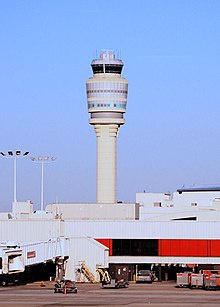Georgia Department of Transportation: Difference between revisions
new key for Category:State agencies of Georgia (U.S. state): "Transportation" using HotCat |
GDoT has moved its web page from http://www.dot.state.ga.us to http://www.dot.ga.gov and the "Website" entry has been modified to reflect that. |
||
| Line 24: | Line 24: | ||
|child1_agency = |
|child1_agency = |
||
|child2_agency = |
|child2_agency = |
||
|website = http://www.dot |
|website = http://www.dot.ga.gov/ |
||
|footnotes = |
|footnotes = |
||
}} |
}} |
||
Revision as of 21:55, 12 February 2013
| File:Gdot logo.png | |
| Agency overview | |
|---|---|
| Formed | 1972 |
| Preceding agencies |
|
| Jurisdiction | Georgia, U.S. |
| Headquarters | Atlanta |
| Employees | 5817 (2008)[1] |
| Annual budget | |
| Agency executive |
|
| Website | http://www.dot.ga.gov/ |
The Georgia Department of Transportation (GDOT) is the organization in charge of developing and maintaining all state and federal roadways in the U.S. state of Georgia. In addition to highways, the department also has a limited role in developing public transportation and general aviation programs. GDOT is headquartered in downtown Atlanta and is part of the executive branch of state government. [2]
GDOT has broken up the state of Georgia into seven districts in order to facilitate regional development. Each district is responsible for the planning, design, construction and maintenance of the state and federal highways in their region.
Ground transportation
Highway system

The state of Georgia has 1,244 miles of interstate highway within its borders. Georgia's major Interstate Highways are I-95, I-75, I-16, I-85, I-20 . Other important interstate highways are I-24 and I-59. I-285 is Atlanta's perimeter route and I-575 connects with counties in north Georgia on I-75.[3] The Georgia Department of Transportation maintains only 16 percent of the roads in the state. The other 84 percent are the responsibility of the counties and cities; 75 percent of those roads are county roads.[4]
The Freeing the Freeways program is a project which involved widening some of the freeways in Atlanta. The project took 17 years to create, cost $1.5 billion, and doubled Atlanta's freeway lane miles from 900 to 1,851 miles (1,448 to 2,979 km). One freeway that was involved in the project was the I-75/I-85 Downtown Connector. Another project was the construction of the Tom Moreland Interchange.
Railroads
Major freight railroads in Georgia include CSX and Norfolk Southern. Passenger service in Georgia is available on two Amtrak routes: the Crescent, which runs from New York to Washington, D.C., through north Georgia and Atlanta to New Orleans and the other runs from New York to the Georgia coast and from there to Florida.[5]
Air transportation

Georgia's principal airport is Hartsfield-Jackson Atlanta International Airport (ATL), the world's busiest passenger airport.[6] Georgia has one hundred seven public-use airports, nine of which are commercial-aviation airports and ninety-eight which are general-aviation airports. Two of the state's important airports are Savannah/Hilton Head International Airport, which serves over 1,700,000 passengers each year and DeKalb Peachtree Airport in Chamblee, Georgia.[7]
History
Origins
An act of the Legislature created the State Highway Department on August 16, 1916. Two years later, in 1918, the creation of the State Highway Department was followed by creation of the Georgia State Highway Commission, which made surveys and oversaw plans for road projects in Georgia.[8] Finally, in 1972, it was followed by the creation of the Georgia Department of Transportation.[9]
Department management
Georgia DOT is governed by a 13-member State Transportation Board that is elected by the Georgia General Assembly for a five-year[10] term and is headed by a commissioner chosen from among the board members.[11] The board's powers include designating which public roads are encompassed within the state highway system; approving long-range transportation plans; overseeing the administration of construction contracts; and authorizing lease agreements. Offices within the board, other than Commissioner, are Deputy Commissioner; Chief Engineer and Treasurer.[12]
The Georgia Department of Transportation has several different divisions. They include:
- Division of Administration
- Chief Engineer
- Communications Division
- Division of Construction
- Division of Equal Employment Opportunity
- Division of Field Districts
- Division of Information Technology
- Division Legal Services
- Division of Operations
- Division of Planning, Data & Intermodal Development
- Division of Preconstruction
- Special Staff
- Treasurer
Possible reorganization
In February 2009, Governor Sonny Perdue, Lieutenant Governor Casey Cagle, and Speaker of the House Glenn Richardson announced a plan that would remove almost all authority from GDOT and the legislature and put it under themselves in a new State Transportation Authority. This would merge the Georgia Regional Transportation Authority (GRTA) and State Road and Tollway Authority (SRTA) together, leaving GDOT only to maintain roads. (Eliminating GDOT entirely would require an amendment to the state constitution.) On February 26, the GDOT board retaliated against chairwoman Gena Evans (who had been picked by Perdue) by firing her.
The state previously had a system under the governor rather than the legislature, in which he could (and often did) withhold highway funds from electoral districts represented by his political opponents. This system of political corruption and payback was reformed in 1963.[13]
References
- ^ a b "2008 Annual Report" (PDF). Retrieved 2010-08-23.
- ^ Georgia Department of Transportation
- ^ Interstate Highway System, Accessed June 17, 2008
- ^ Other Georgia Highways, Accessed June 17, 2008
- ^ Railroads, Accessed June 17, 2008
- ^ Hartsfield-Jackson Atlanta International Airport, Accessed June 18, 2008
- ^ Public-Use Airports, Accessed June 18, 2008
- ^ Road Building in the 20th Century
- ^ Georgia Department of Transportation article, Accessed January 17, 2007
- ^ GDOT: State Transportation Board
- ^ GDOT Organizational Chart
- ^ Top Management
- ^ http://www.ajc.com/news/content/metro/stories/2009/02/22/georgia_transportation_board.html
